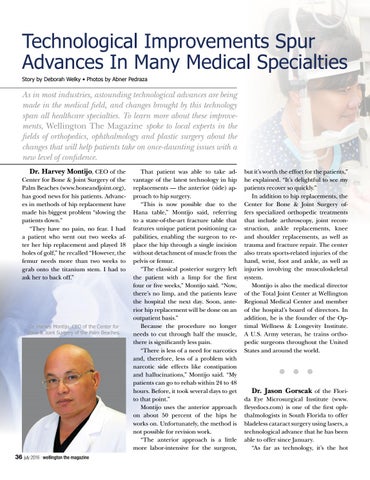Technological Improvements Spur Advances In Many Medical Specialties Story by Deborah Welky • Photos by Abner Pedraza
As in most industries, astounding technological advances are being made in the medical field, and changes brought by this technology span all healthcare specialties. To learn more about these improvements, Wellington The Magazine spoke to local experts in the fields of orthopedics, ophthalmology and plastic surgery about the changes that will help patients take on once-daunting issues with a new level of confidence. Dr. Harvey Montijo, CEO of the Center for Bone & Joint Surgery of the Palm Beaches (www.boneandjoint.org), has good news for his patients. Advances in methods of hip replacement have made his biggest problem “slowing the patients down.” “They have no pain, no fear. I had a patient who went out two weeks after her hip replacement and played 18 holes of golf,” he recalled “However, the femur needs more than two weeks to grab onto the titanium stem. I had to ask her to back off.”
Dr. Harvey Montijo, CEO of the Center for Bone & Joint Surgery of the Palm Beaches.
36
july 2016 | wellington the magazine
That patient was able to take advantage of the latest technology in hip replacements — the anterior (side) approach to hip surgery. “This is now possible due to the Hana table,” Montijo said, referring to a state-of-the-art fracture table that features unique patient positioning capabilities, enabling the surgeon to replace the hip through a single incision without detachment of muscle from the pelvis or femur. “The classical posterior surgery left the patient with a limp for the first four or five weeks,” Montijo said. “Now, there’s no limp, and the patients leave the hospital the next day. Soon, anterior hip replacement will be done on an outpatient basis.” Because the procedure no longer needs to cut through half the muscle, there is significantly less pain. “There is less of a need for narcotics and, therefore, less of a problem with narcotic side effects like constipation and hallucinations,” Montijo said. “My patients can go to rehab within 24 to 48 hours. Before, it took several days to get to that point.” Montijo uses the anterior approach on about 50 percent of the hips he works on. Unfortunately, the method is not possible for revision work. “The anterior approach is a little more labor-intensive for the surgeon,
but it’s worth the effort for the patients,” he explained. “It’s delightful to see my patients recover so quickly.” In addition to hip replacements, the Center for Bone & Joint Surgery offers specialized orthopedic treatments that include arthroscopy, joint reconstruction, ankle replacements, knee and shoulder replacements, as well as trauma and fracture repair. The center also treats sports-related injuries of the hand, wrist, foot and ankle, as well as injuries involving the musculoskeletal system. Montijo is also the medical director of the Total Joint Center at Wellington Regional Medical Center and member of the hospital’s board of directors. In addition, he is the founder of the Optimal Wellness & Longevity Institute. A U.S. Army veteran, he trains orthopedic surgeons throughout the United States and around the world.
• • • Dr. Jason Gorscak of the Florida Eye Microsurgical Institute (www. fleyedocs.com) is one of the first ophthalmologists in South Florida to offer bladeless cataract surgery using lasers, a technological advance that he has been able to offer since January. “As far as technology, it’s the hot
